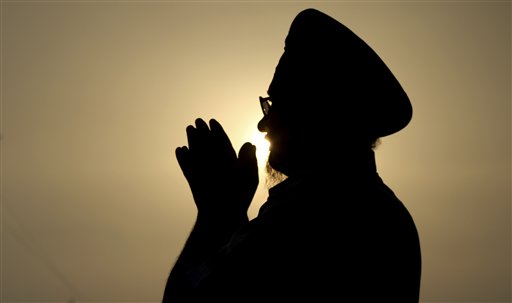Amid details of violence, Sikhism in context
By

Amid details of violence, Sikhism in context
By
As details of Sunday’s deadly shooting at a Sikh temple near Milwuakee, Wis., emerge, many news reports have focused on the differences between Sikhs and Muslims. Sikhs have suffered harrassment in America since 9/11, due in some part to attackers confusing the two groups.
But the Sikh community is defined by more than their differences with other faiths. Nikky-Guninder Kaur Singh joins Worldview Monday to explain Sikhism’s message, practices and identity within America. Singh is a practicing Sikh, and the author of several books about Sikhism, including Sikhism: An Introduction. She chairs the Religion Studies Department at Colby College in Maine.
Here are some take-away points from Singh’s tutorial:
The Sikh religion originated in state of Punjab in northwest India in the 15th century. The word Sikh means “a disciple.”
The religion’s founder was Guru Nanak, born in 1469. Nanak was situated in a very diverse, multicultural, multi-religious state. He had a revelation of the oneness of humanity and the oneness of divinity.
Sikhism believes in the equality of all peoples and invites all faiths to visit their gurudwaras or temples. Guru means teacher and dwara means door, so the term translates roughly as “door to enlightenment.”
Rather than focus on external rituals, the religion focuses on the singular divine. Everyone – Hindus, Muslims, Jews, Christians, Sikhs – are all under that umbrella.
Sikhism’s emphasis is on living one’s everyday life – the secular and the sacred are not divided. It’s about how to be a good human being in this world.
All of Sikh worship centers around their holy book, compiled in 1603 by the 5th Guru, Guru Arjan Dev. The book contains the poetry of the Sikh gurus as well as that of Hindu and Muslim holy men. The text is written in the vernacular, not the language of the elites.
The 10th Guru, Gobind Singh, gave his people a formal identity by giving both men and women the “Five Ks” or five items of Sikh faith. They are:
Long hair. Members of the Sikh faith don’t cut their hair, as a sign of acceptance of the way they are made and acceptance of the body.
The comb. They’re encouraged to be neat and tidy. This is why Sikh men wear turbans and why Sikh women braid their hair or wear it up.
The sword. An ornamental sword meant to be a symbol of protection.
The bracelet. A simple metal bracelet worn as a symbol of dedication that represents the totality of God.
The undergarment. A simple cotton undergarment meant to remind Sikhs to control their sexual desire.